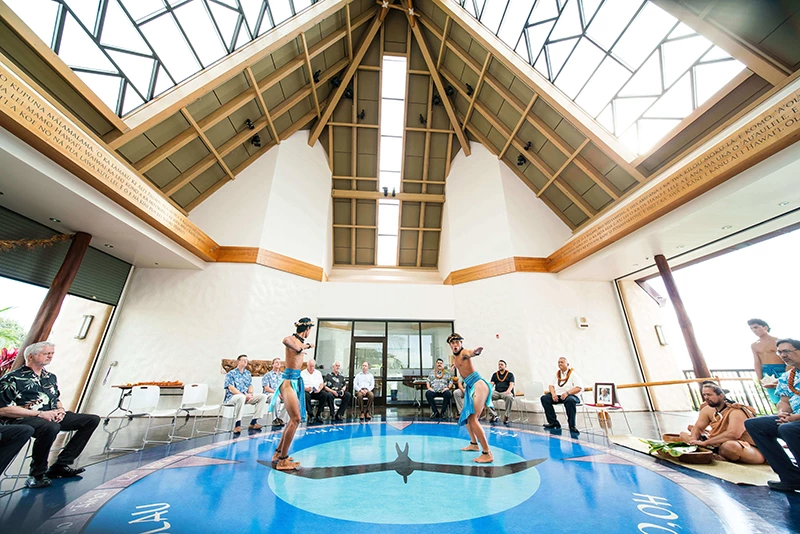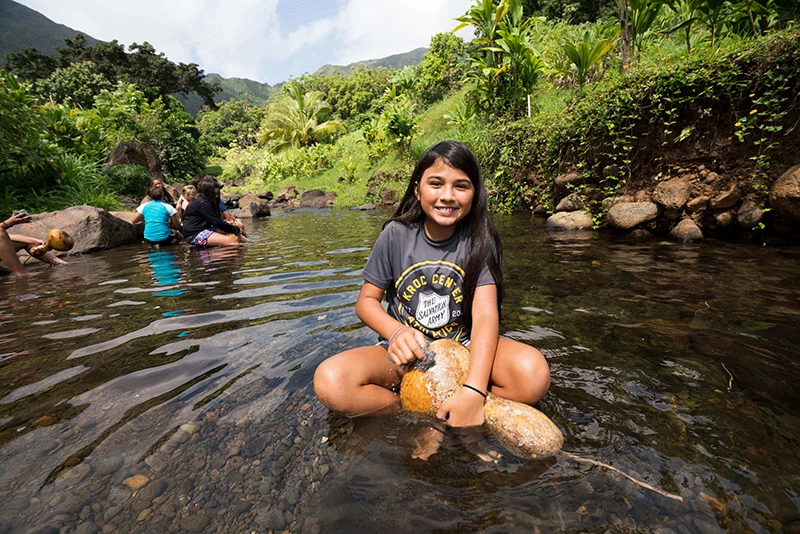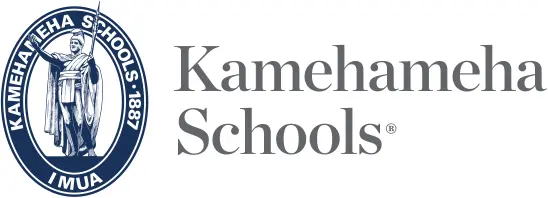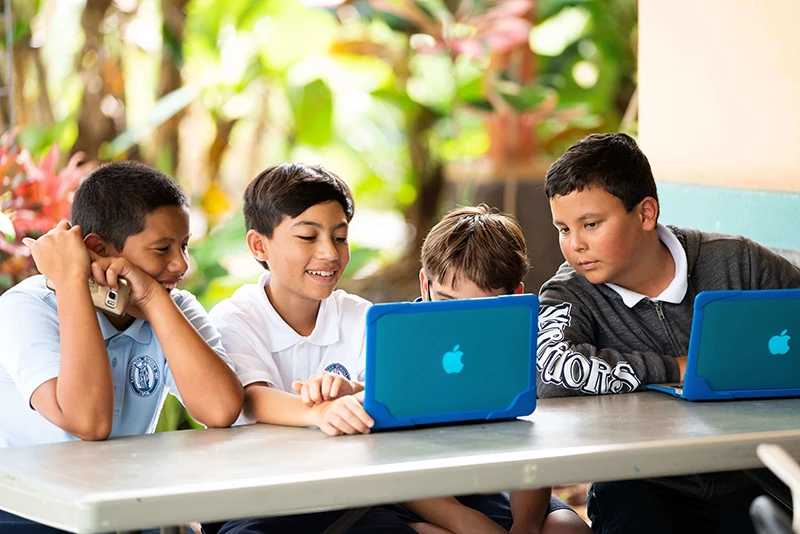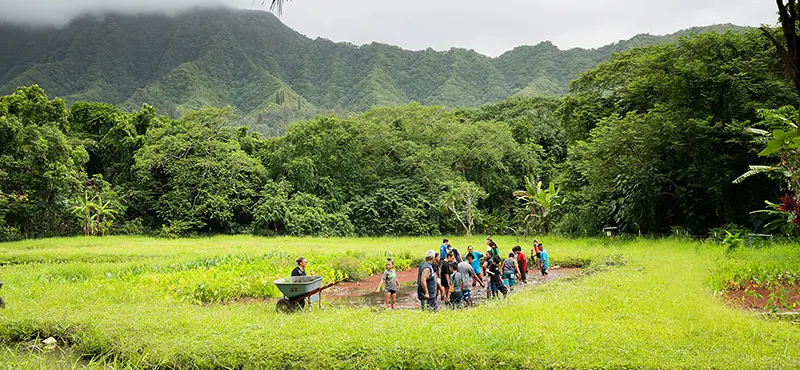When dozens of visitors from Raʻiātea, French Polynesia arrived at the Kūkulu o Kahiki courtyard of Kaʻiwakīloumoku on a cool, crisp January morning, they had a somewhat surprising escort. A single pulelehua fluttered above and around them, seemingly spellbound by the ʻaʻala from the lei draped around the guests’ ʻāʻī.
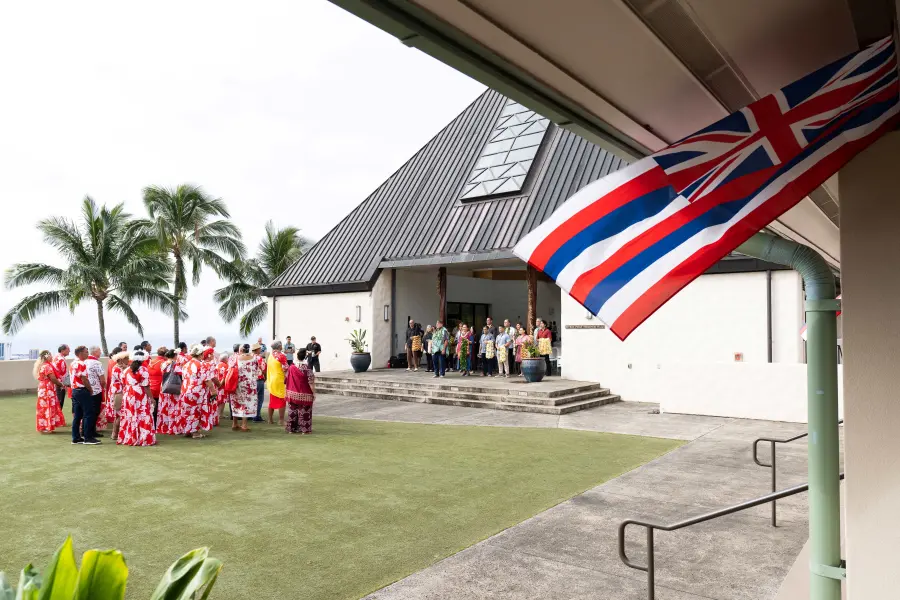
Leaders from Kamehameha Schools and OHA deliver an oli welcoming the delegation from Raʻiātea to Kaʻiwakīloumoku.
Leaders from Kamehameha Schools and OHA deliver an oli welcoming the delegation from Raʻiātea to Kaʻiwakīloumoku.
The winged, welcoming escort into the Myron Pinky Thompson Hale seemed to perfectly match the ʻano of this day, which saw representatives from Kamehameha Schools, the Office of Hawaiian Affairs and all three mayors of Raʻiātea sign an historic agreement. The Cultural Heritage, Education and Community Exchange Agreement is a multi-faceted charter meant to deepen ties across Moananuiākea.
The parties agreed to develop pilina and kākoʻo diverse cultural exchanges and educational opportunities. This includes sports, the arts and professional events. KS and the Raʻiātea delegation also agreed to collaborate on matters of environmental protection and even international recognition.
But before anyone put pen to paper, everyone took time to set intention with oli, mele and hula performed masterfully by the KS Hawaiian Ensemble. Giving heartfelt remarks, the governors of Raʻiātea emphasized the shared history and ancestry between Hawaiians and Tahitians, even noting their home island was once known has Havaiʻi. The Raʻiātea leaders also pointed towards a shared future, tackling issues like cultural preservation and food sustainability.
“Today, we are asked to turn to the teachings of our tupuna and go back and take the time to also reflect on how we produce food ourselves instead of importing everything right now. This is part of the work that Raʻiātea has been doing,” said Tumaraʻa Mayor Cyril Tetuanui.
The declaration signing caps off an effort that spans several years and the entirety of the Polynesian huinakolu. Before arriving to Oʻahu, the French Polynesian delegation had already inked similar agreements with leaders of Rapa Nui to the east and Aotearoa to the southwest. The event on the Kapālama campus completed the third point of that triangle.
The event wouldn’t have been complete without the presence of the Polynesian Voyaging Society, a key connector to all points in Moananuiākea for the past 50 years. Pwo navigator and CEO Nainoa Thompson delivered manaʻo-filled remarks honoring his father and Papa Mau Piailug. He also praised the people of Raʻiātea.
“You are at the heart of what sovereignty is, Raʻiātea, because no matter what the forces are on the outside, you take care of your people.”

Nainoa Thompson, CEO of the Polynesian Voyaging Society, delivers heartfelt remarks during the declaration signing ceremony at the Myron Pinky Thompson Hale, a place named after his pioneering father.
Nainoa Thompson, CEO of the Polynesian Voyaging Society, delivers heartfelt remarks during the declaration signing ceremony at the Myron Pinky Thompson Hale, a place named after his pioneering father.
Thomspon also applauded the kākou effort imbued in the declaration.
“It’s deeper than the paper. It’s deeper than the activation. It’s really about this family coming together. This family is going to take care of each other. This family is never going to break, ever.”
OHA Chair Kaialiʻi Kahele said he took Thompson’s words to heart.
“It gives us an opportunity to collaborate, to share knowledge and hopefully do what Nainoa challenged us to do, which is not just look at today as an opportunity to sign a piece of paper, but actually to forge a bond and a promise to continue to work together for future generations.”
This declaration, with a signature afterwards from the mayor of Raʻiātea’s neighboring island Tahaʻa, is a unique activation of agency. Instead of waiting for state or national leaders to take action, Kamehameha Schools, OHA and these leaders of Tahitian municipalities took it upon themselves to be bridge builders and unifiers.
Randie Fong, Kamehameha Schools’ Executive Cultural Officer, noted this follows the diplomatic legacies of aliʻi such as Kamehameha ʻEkahi and King Kalākaua, who at one time sought a Polynesian Confederation.
“As part of a unifying movement toward oceanic self-determination and cultural empowerment, today’s alliance promotes regular interaction and engagement with the region of our cultural origin and proudly asserts our Hawaiian-Polynesian identity derived from our rich Moananuiākea Pacific heritage,” said Fong.
That unifying spirit was cemented at the end of the signing ceremony. Hawaiians and Tahitians joined hand in hand as they sang the famous mele aloha ʻāina: “Hawaiʻi Aloha.”
TAGS
kamehameha schools,
moananuiākea,
ea activation,
native hawaiian identity
CATEGORIES
Kaipuolono Article, Regions, Kona, O’ahu, Themes, Culture, Community, Leadership, I Mua Kamehameha, Kapalama Newsroom, Kapalama High School, Kapalama Middle School, Kapalama Elementary School, Kapalama Athletics, Kapalama Home, KS Announcements, Newsroom, Hawaii, Kapalama, Maui, Department News, Ho‘okahua, Alumni, Kapalama, Hawaii campus, Kapalama campus, Maui campus, Preschools
Print with photos
Print text only

